Two decades ago, Airbus launched the A330/A340 as a family of twin- and quadjets to tackle the sector above and beyond its existing A300/A310 models in size and range.
Although the aircraft were originally pitched mainly against the then McDonnell Douglas MD-11 in the market to replace DC-10 and Lockheed L-1011 trijets, Airbus knew that it would soon face competition from Boeing. But when the US airframer did retaliate, it was not with a 767 derivative as Airbus had expected, but with an all-new "big-twin" in the form of the 777.
And while this aircraft has gone on to become the undisputed benchmark long-range widebody (except perhaps in Toulouse), Airbus has found a gem in its A330. The twinjet's renaissance - despite the threat of being killed off by the 787 - was confirmed last year when it was the best-selling widebody on the way to accumulating its highest-ever backlog. At more than 410 aircraft, this represents in excess of five years of production.
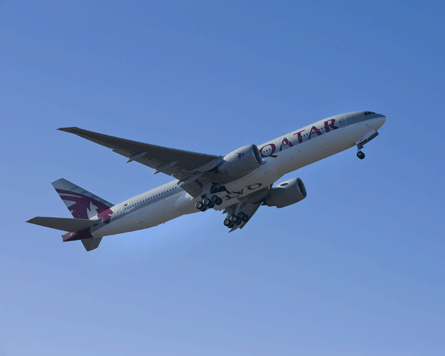 |
|---|
© Boeing |
Meanwhile, sales of the four-engined A340, which had been the lead family member at launch and was the first to enter service in 1993, have been in a downward spiral and are now all but over as the remaining aircraft orders are built at a trickle.
A similar, although less obvious, evolution has occurred to the 777 since its service debut in 1995. The original models (-200/200ER and -300), which like the A330 were all offered with a choice of all of the big three engine makers' powerplants, have been relegated well and truly to a marginal role following the advent of the new 777 family powered exclusively by General Electric's GE90-115 engine.
The switch has taken the 777 from being powered by engines in the 90-100,000lb thrust (400-445kN) bracket to 115,000lb.
While the firm backlog for GE90-115 777 variants (including the -200LR-based 777F) has ballooned to more than 320 aircraft, the unfilled order tally for the original models - unofficially dubbed the Classic - has declined to 25 - ie a similar amount to the current A340 total.
The A340 was Airbus's original long-range product in the days when it did not believe the market for a twinjet of similar capability would find enough market interest due to concerns about long over-water flying. The success of the 767 and the 777 gradually changed Airbus's view on this and it has evolved its own big twin into a strong performer.
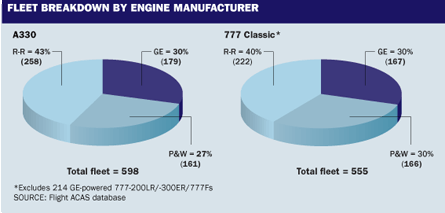 |
|---|
The A330's range development ultimately killed off the original CFM International CFM56-powered A340-300, with Airbus ironically securing its 1,000th order for the twinjet last year as the last of 246 A340-200/300s rolled off the line.
However, Airbus had retained the four-engined approach for long-range/high-capacity and ultra-long-range missions in the form of the A340-600 and -500, respectively. Equipped with Rolls-Royce Trent 500s, the $2.9 billion A340-500/600 programme was launched in 1998. The new family sold reasonably well early on before Boeing finally evolved 777 variants with similar size and range capabilities - the -300ER and -200LR - which entered service in 2004 and 2006, respectively.
The arrival of these new variants of the twinjet gave Airbus a hard time in the marketplace trying to sell the A340 quad with its higher operating costs. Even Airbus's chief salesman John Leahy admitted in 2006 to a "single-digit fuel burn penalty" over the 777, which he said could be "traded off" through financial compensation to operators. However, last year's fuel price rises exaggerated this gap, and it was no surprise that Airbus ended 2008 having had more A340 cancellations than deliveries.
One observer with allegiances closer to the Pacific Northwest than Toulouse recently described the A340's status as "road kill", which Airbus rebuts, although it concedes that the glory years may be over.
"The A340 is not dead," says Airbus head of leasing and investor marketing Mark Pearman-Wright.
Responding to a question at the ISTAT air transport conference in Phoenix during March 2009, Pearman-Wright acknowledged that the quadjet "will become a little bit more marginalised as time goes on" and that Airbus had "taken the decision to replace the A340 with the A350".
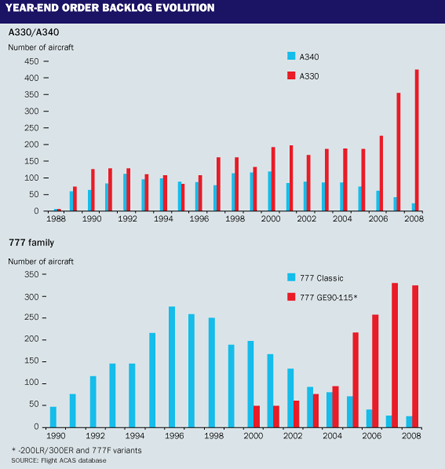 |
|---|
But in the meantime "we continue to build, deliver and sell A340s", says Alan Pardoe, A330/A340/A350 product marketing director. "People have been trying to kill the A340 for a decade, but it's still going."
Despite Pardoe's enthusiasm, the fact is that Airbus delivered just 13 A340s in 2008 and although it secured six new orders, 10 contracts were cancelled or changed, leaving it with just a deficit of four aircraft for the year. Total orders for the -500/600 stand at 139 aircraft.
"The last three years have seen the 777 clobber the A340 by a 15-1 margin, leaving Airbus to ponder what could be done to save the situation," says Richard Aboulafia, who is vice-president analysis at US consultancy Teal Group. "Higher fuel costs exacerbated the operating cost differential between the A340 and the 777," he adds.
"The A350 XWB will make a better 777-200ER/300ER challenger than the A340. The A350 will also destroy the A340-500."
The A340 backlog has declined to 21 aircraft, and Airbus has adjusted the output rate accordingly - it is now running at less than one aircraft a month.
Despite the slowing of the rate, Aboulafia says he expects A340 production "to end in the next two years".
Pardoe points out that the A340 has found a niche in the VIP market, where it has been selling recently and that "there is always a need for [the A340's] long-range hot and high capability which is worth a few aircraft [sales] a year".
In spite of the marginal sales, Airbus continues to develop improvements for the A340. A revised belly fairing is about to be flight-tested on the A340-600 development aircraft, which will have lower drag and is "worth around 1% off the fuel burn", says Pardoe. The upper part above the wing is "more faired", he adds, and will be standard on new-build aircraft from the end of this year with a retrofit also available.
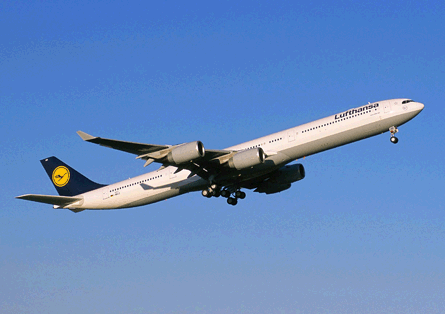 |
|---|
© Airbus |
The quadjet has also benefited from an increase in maintenance check intervals that Airbus has negotiated with regulatory authorities for the A330/A340, which Pardoe says is "worth something like a 6% reduction in airframe direct maintenance cost". Already approved is an increase in the A check interval from 600h to 800h and structural check from 10 years to 12 years. Still pending is an extension in the C check interval from 18 to 21-24 months.
There are 242 A340-300s in service, and although Aboloufia describes the operator list as looking like "a departure board at a third world airport", remarkably few are idle, says Edward Pieniazek, director at UK-based consultancy Ascend Worldwide.
"The A340-300 has long-range capability and 'right-size' credentials for many of the thinner markets. As a result the fleet has been kept busy - almost all are flying today - despite strong payload and performance competition from the 777.
"Most of the few that are parked have end-users already in place. However, the markets stability has been fragile at best, and as more A340s become available, they may become harder to place in the near future."
One likely development as early A340-300s come up for replacement is the development of a passenger-to-freighter (PTF) conversion. Airbus's head of freighter marketing Didier Lenormand says that a "PTF programme is being examined to sustain aircraft values". He adds that the likelihood is that the programme would be launched in around 2014-15 when the "feedstock" for conversions starts from the passenger market.
Pieniazek concurs on the timing, but says that while the A340 has long-term freighter conversion potential "it is behind the A330 in terms of interest".
The single biggest fleet among the mid-size widebodies is the 777, with more than 770 in service. The majority of these are the Classics (555 aircraft), but it looks likely that they will ultimately be matched or even overtaken by the new models.
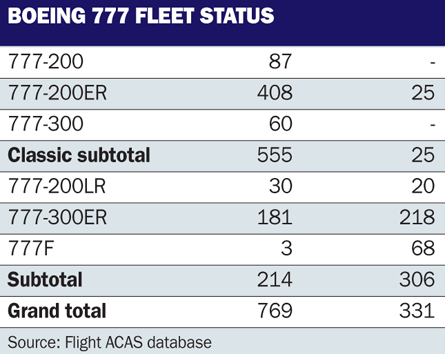 |
|---|
"The 777 orderbook also includes nearly all of the most important airlines in the world - you could say that anyone without a 777 is either not a serious player, or Lufthansa or Qantas," says Aboulafia.
Production of the 777 Classic is now exclusively centred on the -200ER, with the last of the 60 stretched -300s built having been delivered in 2006. But the success of the new-generation 777 models has seen the Classic take second place in terms of production. Last year just three of the 61 777s delivered were the earlier -200ER model, while the 54 orders taken in 2008 were also split heavily in favour of the new versions (41 versus 13). So unsurprisingly the Classic's proportion of the overall 777 backlog has declined to less than 8%.
"I'm confident we will go on selling -200ERs, but we probably aren't going to see any huge individual orders," says Kostya Zolotusky, who is Boeing's managing director of capital markets development.
Although the -200ER has a different structure and wing to the newer models, Zolotusky points out that production of the different variants is integrated "so it doesn't matter which aircraft are coming through". He adds that in fact it is better for output of the higher weight -200LR/300ER versions to be greater, as they generate more value for Boeing.
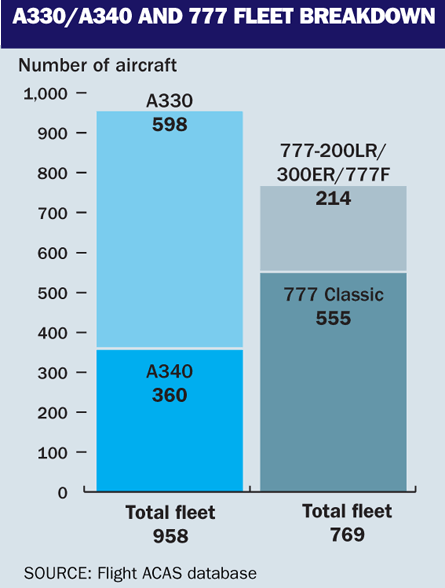 |
|---|
One perceived disadvantage of the new models - if you are a customer - is that unlike the earlier versions, GE is the sole-source engine supplier. However, this problem has proved far less of an issue than expected, says Aboulafia: "The GE90's power advantage, and GE's financial help, seem to be enough to compensate for the 777-200LR/300ER orders lost due to airlines that really wanted the R-R Trent."
The -200LR is dimensionally identical to the -200ER, but its higher weight, more powerful engines and increased fuel tankage options give it significantly more range (Boeing quotes a maximum range with auxiliary fuel in excess of 17,300km/9,350nm). But Zolotusky refutes suggestions that this makes the -200LR a niche aircraft suitable for operators needing ultra-long-range capability for specific city-pair connections half a world apart. He points out that it is the -200LR's impressive payload capability as much as its range that will appeal to -200ER operators: "We anticipate that two-thirds of the applications of the -200LR will be for additional payload capability from -200ER operators [rather than range]."
Ascend's Pieniazek notes that like the A340-300, "the majority of 777-200s are flying, although some airlines are looking to scale back capacity. There are -200ERs and plain 200s on offer and available today, without much prospect of an easy placement."
He points out that unlike the A340, the 777-200/200ER was delivered with three engine choices "which historically has increased the remarketing challenge".
And while the big sales may be over for the -200ER, Zolotusky believes that it still has a long and healthy life ahead of it as a passenger aircraft. "The A340 is 'the canary in the coal mine'. As long as there are A340s in service, no 777s will be put down. He adds that the 777-200ER's advantage is recognised by appraisers as it has "a beautiful residual value performance".
At some point a Boeing converted freighter (BCF) modification programme will become available, Zolotusky says, but nothing is imminent: "The BCF market is coming, but I don't see this happening tomorrow because there is still demand for the passenger aircraft."
Pieniazek sees the -200/200ER "offering good freighter potential, especially for integrators, but serious commitment is unlikely for some time. With the market struggling to absorb 777Fs, it can't be any easier for the -200."
In the 777/A340 stakes, Boeing seems to have had it all its own way in the battle with Airbus, but there is a threat on the horizon from Toulouse, says Aboulafia. "The A350-1000 looks potentially quite good against the 777-300ER, while the A350-900 and 787-10 will eclipse the 777-200ER/LR."
So while the closest rival the -200ER in the near-term is the home-grown -200LR, Boeing has to be prepared for foreign competition when the A350 arrives in 2013. Anything from a 777 mid-life update, a 787-based development and an all-new 777 replacement is possible, says Zolotusky. "We're completely undecided on 777 upgrades. We need to see what the competition is going to build first."
What is clear is that if the A350 delivers advertised, Boeing will need to give the 777 more than a cabin refresh and a new paint scheme to stay competitive.
A330 - FROM OBSOLESCENCE TO TOAST OF TOULOUSE
For an aircraft that has been under attack from both home and abroad, the A330 appears to have an extremely bright future ahead.
Orders, backlog and output are at record levels, there is product development aplenty and new cargo and tanker variants are in production.
Few people - even among Airbus's sales team - could have predicted such huge success a few years as the A330 appeared to face rapid technical obsolescence, initially from the rival Boeing 787 followed quickly by its new sibling, the A350 XWB.
"Some of this success has been due to heavy discounting by Airbus, but pricing is getting better due to 787 delays, and due to the strong likelihood of 787 performance shortfalls, for the first batch at least," says Teal Group's vice-president analysis Richard Aboulafia. "Ironically, 787 delays mean that Boeing penalty payments are helping to pay for A330s as interim capacity."
Airbus has given the A330 a leg-up through a range boost (from 2010), which Airbus's A330/A340/A350 product marketing director Alan Pardoe says has been a significant weapon in the battle with the 787-8: "We've improved the A330-200's range and our competitor has diminished the range of its product [in early production aircraft], so one perceived advantage of the 787 has simply gone away."
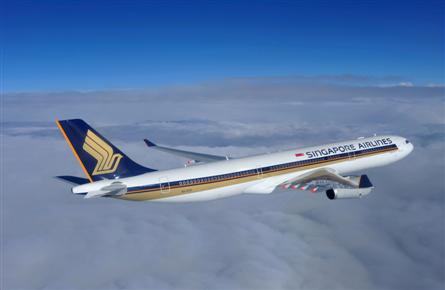 |
|---|
© Airbus |
The 5t maximum take-off weight increase will be available on new-build A330-200s from September next year, providing operators with a 610km (330nm) range boost to more than 12,600km. It will also be available as a retrofit to A330-200s built from February 2004 towards the end of next year. "The increase gives us the extra range to mix with those bigger aircraft like the A340-300 and 777-200ER," says Pardoe.
Korean Air became the first airline to commit to the 238t version with an order for six earlier this year. In lieu of the range boost, the higher weight can be used to gain an extra 3.4t of payload.
Pardoe says the enhancement will not push up the empty weight, and in fact Airbus has managed to remove around 200kg from the airframe as part of a weight-saving effort that will help counter the modifications required to comply with new centre fuel tank inerting and cabin flammability rules. "The good news is that the A330-300 does not have a centre fuel tank so does not need the inerting system," he adds.
In parallel with the extra range, Airbus is pushing the A330's extended twin operations clearance out from 180min to 240min "by later this year", says Pardoe.
While the larger A330-300 was the first variant of the twinjet to be developed, it had for many years been overshadowed by the sales success of its longer-range little sister. However, product development of the larger model has boosted both its range and sales fortunes, and its orderbook is now just one sale away from 400 units. "This year we will, for the first time in many years, deliver as many if not more A330-300s than -200s," says Pardoe.
The A330 is the platform for Airbus's military tanker transport offerings, which have had some success in recent campaigns - although frustratingly for Airbus the USA reneged on its selection of the twinjet last year in the US Air Force KC-X competition.
The first new-build A330-200F will fly towards the end of this year and Airbus's cargo arm is already talking about the availability of a freighter conversion programme for the A330-300 in around four to five years' time. Airbus Military also sees the potential for ex-passenger aircraft to undergo tanker/transport conversion to supplement the new-build aircraft on offer.
- All the latest news, images and video from the Paris Air Show
Source: Flight Daily News























